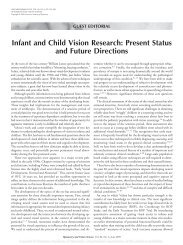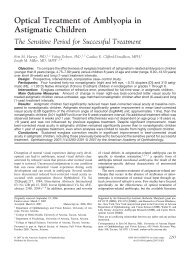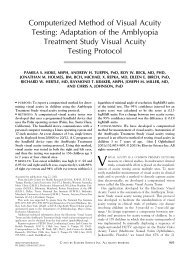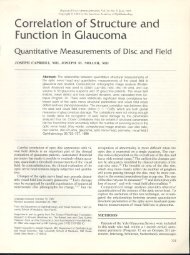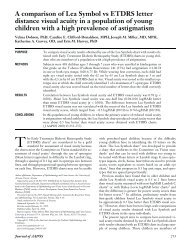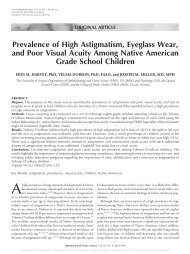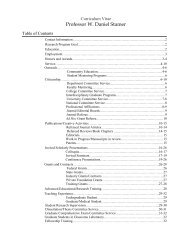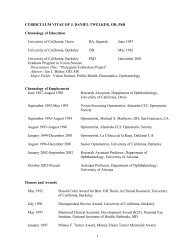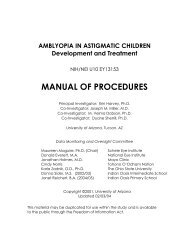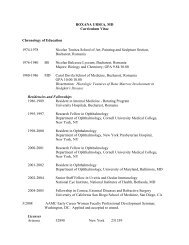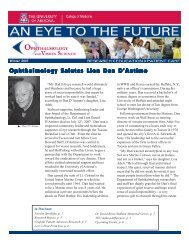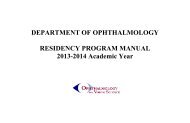Prescribing Eyeglass Correction for Astigmatism in Infancy and Early ...
Prescribing Eyeglass Correction for Astigmatism in Infancy and Early ...
Prescribing Eyeglass Correction for Astigmatism in Infancy and Early ...
Create successful ePaper yourself
Turn your PDF publications into a flip-book with our unique Google optimized e-Paper software.
Journal of AAPOS<br />
Volume 9 Number 2 April 2005 Harvey et al 191<br />
TABLE 2. Percentiles based on survey responses from 412 AAPOS members with “would not prescribe” responses <strong>in</strong>cluded (Numbers <strong>in</strong> parentheses<br />
represent percentiles calculated with “would not prescribe” responses excluded <strong>in</strong> cases where percentiles changed)<br />
Condition<br />
Bilateral<br />
astigmatism<br />
Astigmatic<br />
anisometropia<br />
Age Range<br />
(months)<br />
In summary, the results of the present survey <strong>in</strong>dicate that<br />
there is considerable variability across age <strong>in</strong> the level of<br />
astigmatism <strong>and</strong> astigmatic anisometropia at which pediatric<br />
ophthalmologists <strong>in</strong>dicate they would likely prescribe eyeglasses<br />
<strong>for</strong> <strong>in</strong>fants <strong>and</strong> young children. It is important to<br />
recognize that this survey represents the op<strong>in</strong>ion of respondents,<br />
but may not reflect the actual prescrib<strong>in</strong>g practices that<br />
would be determ<strong>in</strong>ed by a chart review of each respondent’s<br />
patients. One factor underly<strong>in</strong>g the variability across age <strong>in</strong><br />
prescrib<strong>in</strong>g practices is likely to be the lack of data on the age<br />
at which bilateral <strong>and</strong> unilateral astigmatism need to be corrected<br />
to prevent the development of amblyopia. Further<br />
research on the effect of uncorrected astigmatism on the<br />
development of vision <strong>in</strong> <strong>in</strong>fants <strong>and</strong> young children would<br />
allow the development of prescrib<strong>in</strong>g guidel<strong>in</strong>es based on<br />
empirical results rather than on general consensus.<br />
This work was supported by Grant U10 EY13153<br />
(E.M.H.) from the National Eye Institute of the National<br />
Institutes of Health, Department of Health <strong>and</strong> Human<br />
Services, <strong>and</strong> by unrestricted funds to the Department of<br />
Ophthalmology <strong>and</strong> Vision Science from Research to Prevent<br />
Bl<strong>in</strong>dness.<br />
References<br />
1. Mitchell DE, Freeman RD, Millodot M, Haegerstrom G. Meridional<br />
amblyopia: evidence <strong>for</strong> modification of the human visual system<br />
by early visual experience. Vision Res 1973;13:535-58.<br />
2. Cobb SR, MacDonald CF. Resolution acuity <strong>in</strong> astigmats: evidence<br />
<strong>for</strong> a critical period <strong>in</strong> the human visual system. Br J Physiol Opt<br />
1978;32:38-49.<br />
3. Daugman JG. Visual plasticity as revealed <strong>in</strong> the two-dimensional<br />
modulation transfer function of a meridional amblyope. Hum Neurobiol<br />
1983;2:71-6.<br />
4. Gwiazda J, Bauer J, Thorn F, Held R. Meridional amblyopia does result<br />
from astigmatism <strong>in</strong> early childhood. Cl<strong>in</strong> Vis Sci 1986;1:145-52.<br />
5. Dobson V, Miller JM, Harvey EM, Mohan KM. Amblyopia <strong>in</strong><br />
astigmatic preschool children. Vision Res 2003;43:1081-90.<br />
Percentiles (numbers are<br />
Diopters)*†<br />
Miller <strong>and</strong> Harvey 15<br />
25th 50th 75th 25th 50th 75th<br />
0to6 3.00‡ 4.00<br />
(3.50)<br />
AAO 16<br />
6.25<br />
(4.25) 3.00<br />
6to12 2.50 3.00‡ 4.00<br />
2.00 2.50 3.00<br />
12 to 24 >2.00 >2.50‡ 3.00 2.50<br />
24 to 36 >2.00 >2.00 >2.75‡<br />
(2.50)<br />
2.00 1.75 2.00 2.50<br />
0to6 2.00‡ 3.00‡<br />
(2.00)<br />
4.00<br />
(3.00) 2.50<br />
6to12 1.75 2.00‡ 3.00‡<br />
12 to 24 1.50 2.00‡ 2.00‡ 2.00<br />
24 to 36 1.25 1.50 2.00‡ 2.00<br />
Not surveyed<br />
*Bold numbers are most consistent with Miller <strong>and</strong> Harvey survey. 16<br />
†The CRYO-ROP study required correction of astigmatism 3.00 D at age 1 <strong>and</strong> 2 years, <strong>and</strong> correction of astigmatic anisometropia 2.00 D at the same ages, but only if<br />
amblyopia was present.<br />
‡Areas most consistent with AAO Guidel<strong>in</strong>es. 17<br />
6. Howl<strong>and</strong> HC, Atk<strong>in</strong>son J, Braddick O, French J. Infant astigmatism<br />
measured by photorefraction. Science 1978;202:331-3.<br />
7. Moh<strong>in</strong>dra I, Held R, Gwiazda J, Brill S. <strong>Astigmatism</strong> <strong>in</strong> <strong>in</strong>fants.<br />
Science 1978;202:329-31.<br />
8. Atk<strong>in</strong>son J, Braddick O, French J. Infant astigmatism: its disappearance<br />
with age. Vision Res 1980;20:891-3.<br />
9. Moh<strong>in</strong>dra I, Held R. Refraction <strong>in</strong> humans from birth to five years.<br />
Doc Ophthalmol Proc Ser 1981;28:19-27.<br />
10. Gwiazda J, Scheiman M, Moh<strong>in</strong>dra I, Held R. <strong>Astigmatism</strong> <strong>in</strong> children:<br />
changes <strong>in</strong> axis <strong>and</strong> amount from birth to six years. Invest<br />
Ophthalmol Vis Sci 1984;25:88-92.<br />
11. Howl<strong>and</strong> HC, Sayles N. Photorefractive measurements of astigmatism <strong>in</strong><br />
<strong>in</strong>fants <strong>and</strong> young children. Invest Ophthalmol Vis Sci 1984;25:96-102.<br />
12. Mayer DL, Hansen RM, Moore BD, Kim S, Fulton AB. Cycloplegic<br />
refractions <strong>in</strong> healthy children aged 1 through 48 months. Arch<br />
Ophthalmol 2001;119:1625-8.<br />
13. Ingram RM, Barr A. Changes <strong>in</strong> refraction between the ages of 1 <strong>and</strong><br />
3 1/2 years. Br J Ophthalmol 1979;63:339-42.<br />
14. Abrahamsson M, Fabian G, Sjöstr<strong>and</strong> J. Changes <strong>in</strong> astigmatism<br />
between the ages of 1 <strong>and</strong> 4 years: a longitud<strong>in</strong>al study. Br J Ophthalmol<br />
1988;72:145-9.<br />
15. Atk<strong>in</strong>son J, Anker S, Bobier W, Braddick O, Durden K, Nard<strong>in</strong>i M,<br />
Watson P. Normal emmetropization <strong>in</strong> <strong>in</strong>fants with spectacle correction<br />
<strong>for</strong> hyperopia. Invest Ophthalmol Vis Sci 2000;41:3726-31.<br />
16. Miller JM, Harvey EM. Spectacle prescrib<strong>in</strong>g recommendations of<br />
AAPOS members. J Pediatr Ophthalmol Strabismus 1998;35:51-2.<br />
17. American Academy of Ophthalmology. Pediatric Eye Evaluations<br />
Preferred Practice Patterns. San Francisco: American Academy of<br />
Ophthalmology; 2002.<br />
18. Cryotherapy <strong>for</strong> Ret<strong>in</strong>opathy of Prematurity Cooperative Group. Multicenter<br />
trial of cryotherapy <strong>for</strong> ret<strong>in</strong>opathy of prematurity. One-year<br />
outcome—structure <strong>and</strong> function. Arch Ophthalmol 1990;108:1408-16.<br />
19. Multicenter Trial of Cryotherapy <strong>for</strong> Ret<strong>in</strong>opathy of Prematurity<br />
CRYO-ROP). Manual of Procedures, II: Phase II Follow-up Study.<br />
Spr<strong>in</strong>gfield, VA: National Technical In<strong>for</strong>mation Service; 1993. US<br />
Dept of Commerce publication PB 93-134427.<br />
20. Sjöstr<strong>and</strong> J, Abrahamsson M. Risk factors <strong>in</strong> amblyopia. Eye 1990;<br />
4:787-93.<br />
21. Abrahamsson M, Sjöstr<strong>and</strong> J. Astigmatic axis <strong>and</strong> amblyopia <strong>in</strong> childhood.<br />
Acta Ophthalmol Sc<strong>and</strong> 2003;81:33-7.



